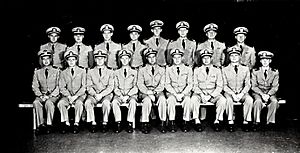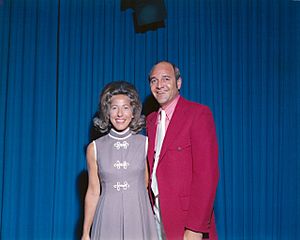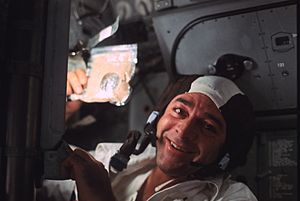Ronald Evans (astronaut) facts for kids
Quick facts for kids
Ronald Evans
|
|
|---|---|

Evans in 1971
|
|
| Born |
Ronald Ellwin Evans Jr.
November 10, 1933 St. Francis, Kansas, U.S.
|
| Died | April 7, 1990 (aged 56) Scottsdale, Arizona, U.S.
|
| Alma mater |
|
| Occupation | |
| Awards |
|
| Space career | |
| NASA astronaut | |
| Rank | Captain, USN |
|
Time in space
|
12d 13h 52m |
| Selection | 1966 NASA Group 5 |
|
Total EVAs
|
1 |
|
Total EVA time
|
1 hour 5 minutes |
| Missions | Apollo 17 |
|
Mission insignia
|
|
| Retirement | March 15, 1977 |
Ronald Ellwin Evans Jr. (born November 10, 1933 – died April 7, 1990) was an American electrical and aeronautical engineer. He was also a brave officer and pilot in the United States Navy, and a NASA astronaut. He served as the Command Module Pilot on Apollo 17. This mission was the last time humans traveled to the Moon.
Evans was one of 24 astronauts who flew to the Moon. He was also one of 12 people who orbited the Moon but did not land on its surface.
Before becoming an astronaut, Evans earned a degree in electrical engineering from the University of Kansas. He joined the U.S. Navy in 1956. After becoming a naval aviator (a Navy pilot), he flew fighter jets and completed combat missions during the Vietnam War. In 1964, he earned a master's degree in aeronautical engineering. He reached the rank of captain before retiring from the Navy in 1976.
NASA chose Evans as an astronaut in 1966. His only trip to space was on Apollo 17 in December 1972. This was the last crewed mission to the Moon. On this mission, he was the Command Module Pilot. His crewmates were Commander Gene Cernan and Lunar Module Pilot Harrison Schmitt.
While Cernan and Schmitt explored the Moon's surface, Evans orbited the Moon alone. He orbited a record 75 times. He holds the record for the most time spent orbiting the Moon: 147 hours and 43 minutes. On the way back to Earth, Evans performed a extravehicular activity (EVA), also known as a spacewalk. He went outside the spacecraft to get film from the service module. This spacewalk was done farther from any planet than any other spacewalk in history. It was also the last spacewalk of the Apollo program.
In 1975, Evans was a backup pilot for the Apollo–Soyuz Test Project mission. He also helped develop the Space Shuttle. He retired from NASA in March 1977. After that, he worked as an executive in the coal industry.
Contents
Early Life and Education
Ronald Ellwin Evans was born on November 10, 1933, in St. Francis, Kansas. His parents were Clarence Ellwin Evans and Marie Priebe. He had two younger brothers. Ronald was active in the Boy Scouts of America and earned the rank of Life Scout.
He started high school in St. Francis but moved to Topeka, Kansas with his family. In Topeka, he attended Highland Park High School. He was part of the Student Council and president of the Science Club. He also played American football for the school team.
Evans decided to study electrical engineering at the University of Kansas. He started college in September 1951. To pay for his studies, he received a scholarship from the Naval Reserve Officers Training Corps (NROTC). This program involved weekly parades and summer cruises on Navy ships. One cruise was on the battleship USS Wisconsin.
During his second year, he learned about naval aviation. This experience inspired him to become a Navy pilot. He graduated with his Bachelor of Science degree in electrical engineering in June 1956.
In December 1955, the Navy offered Evans a job as an ensign and a student pilot. He began flight training in February 1956 at Naval Air Station Pensacola. He learned to fly different planes, including the Beechcraft T-34 Mentor and the North American T-28 Trojan. He also practiced landing on an aircraft carrier.
On April 12, 1957, Evans officially became a naval aviator. He then became a fighter pilot with Fighter Squadron 142 (VF-142). This squadron was based in Naval Air Station Miramar in California. He flew the North American FJ-3 Fury and later the Vought F-8 Crusader. He was promoted to lieutenant (junior grade). On December 22, 1957, he married Janet Merle Pollom. They had two children, Jaime and Jon.
In 1959, VF-142 went on a cruise to the Western Pacific aboard the new aircraft carrier USS Ranger. Evans was promoted to lieutenant in June. He then became a flight instructor for the F8U Crusader.
In 1962, Evans attended the U.S. Naval Postgraduate School in Monterey, California. While there, NASA announced it was looking for new astronauts. Evans applied but was not selected at that time. He continued his studies and earned a Master of Science degree in aeronautical engineering in 1964.
After his studies, Evans rejoined Fighter Squadron 51 (VF-51). He flew the F8U Crusader again. In September 1965, his ship, the USS Ticonderoga, went to Dixie Station off the coast of South Vietnam. From there, aircraft launched attacks during the Vietnam War. Evans flew combat missions and his aircraft was hit by ground fire.
In September 1965, NASA announced another call for pilot astronauts. Evans volunteered again. He completed the required tests and interviews. On March 26, 1966, he received news that he had been selected for astronaut training. He was one of 19 astronauts chosen by NASA in April 1966.
Evans completed a seven-month tour flying combat missions. He had logged 2,084 hours of flight time in jets and flown 112 combat missions. He received several awards for his service, including five Air Medals.
NASA Career
After being selected, Evans moved his family to El Lago, Texas, near the Johnson Space Center. He was assigned to the support crew for Apollo 1, the first crewed Project Apollo mission. Support crews help develop mission rules, flight plans, and checklists. They also work in simulators and prepare the spacecraft. Tragically, the prime crew of Apollo 1 died in a fire during a test in January 1967.
When Apollo missions resumed, Evans was part of the support crew for Apollo 7, the first crewed flight after the fire. He also served on the support crew for Apollo 11, the first Moon landing. He was a capsule communicator (CAPCOM) for Apollo 7, Apollo 11, and Apollo 14. A CAPCOM is the person in Mission Control who talks directly to the astronauts in space.
Backup Crew Assignments
NASA had a system where backup crews would often become the prime crew for a later mission. Evans was chosen as the Command Module Pilot for the backup crew of Apollo 14. His crewmates were Gene Cernan as Commander and Joe Engle as Lunar Module Pilot. On October 1, 1969, Evans was promoted to commander in the Navy.
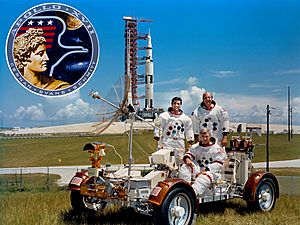
The plan was for the Apollo 14 backup crew to become the prime crew for Apollo 17. However, there was pressure from scientists to send a geologist to the Moon. This led to Harrison Schmitt, a geologist astronaut, being assigned to Apollo 17. This meant Joe Engle, a pilot, was removed from the crew. Cernan, Evans, and Schmitt then formed the prime crew for Apollo 17.
Evans and his crewmates trained hard. They studied geology with Farouk El-Baz, learning to observe and photograph features from orbit. They would fly over geological sites in Northrop T-38 Talon jets, recording their observations.
Apollo 17 Mission
Apollo 17 launched at night, with an estimated 700,000 people watching. It was the largest crowd since Apollo 11. The mission kept Evans very busy.
While Cernan and Schmitt landed on the Moon, Evans stayed in orbit aboard the Command Module America. His tasks included making visual geological observations and taking photographs of specific targets. He also controlled cameras and other scientific equipment in the service module's SIM bay. His crewmates called him "Captain America."
Evans was responsible for piloting the Command Module in orbit. He adjusted its path to stay at the correct distance from the Moon. He also performed a "plane change" maneuver to align the Command Module's path with the Lunar Module's return path. This made it easier for them to meet up in orbit. He holds the record for the most time spent in lunar orbit: 147 hours, 43 minutes, and 37.11 seconds.
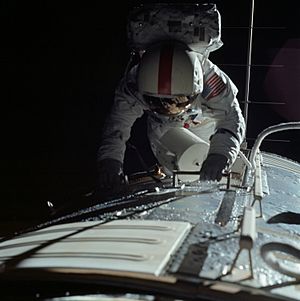
On the way back to Earth, Evans performed a spacewalk that lasted one hour, five minutes, and 44 seconds. During this spacewalk, he made three trips to the SIM bay. He retrieved film from the lunar sounder, the panoramic camera, and three camera mapping cassettes. He also inspected the equipment bay. This spacewalk was televised live.
After a flight of 301 hours, 51 minutes, and 59 seconds, America splashed down in the Pacific Ocean. The USS Ticonderoga recovered the spacecraft and the crew.
Evans was promoted to captain in January 1973. He received his Navy astronaut wings. The Apollo 17 crew was celebrated with parties and receptions. They met President Richard Nixon at the White House.
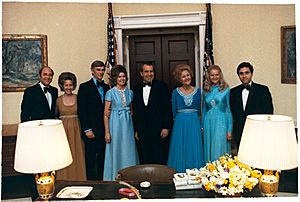
Evans later served as a backup pilot for the 1975 Apollo–Soyuz Test Project (ASTP) mission. He retired from the U.S. Navy as a captain on April 30, 1976. He continued to work at NASA, helping with the development of the Space Shuttle program. He retired from NASA on March 8, 1977.
Later Years and Legacy
After leaving NASA, Evans moved to Scottsdale, Arizona. He worked as a marketing director for an energy company. Later, he joined Sperry Flight Systems, which made parts for the Space Shuttle. He then started his own consulting company.
Ronald Evans died in his sleep from a heart attack at his home in Scottsdale on April 7, 1990. He was 56 years old. He was buried at the Valley Presbyterian Church Memorial Garden in Paradise Valley, Arizona.
Awards and Honors
Evans received many awards for his service and achievements:
- NASA Distinguished Service Medal (1973)
- Johnson Space Center Superior Achievement Award (1970)
- Navy Distinguished Service Medal (1973)
- Navy Astronaut Wings
- Eight Air Medals
- Vietnam Service Medal
- Navy Commendation Medal
He was also recognized by his home state, being named Kansan of the Year in 1972. He was inducted into the International Space Hall of Fame in 1983. On October 4, 1997, he was inducted into the U.S. Astronaut Hall of Fame.
Images for kids
-
The USS Ticonderoga recovers the Apollo 17 spacecraft in 1972
See also
 In Spanish: Ronald Evans (astronauta) para niños
In Spanish: Ronald Evans (astronauta) para niños


